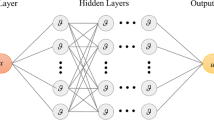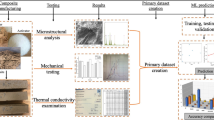Abstract
In the last decades, a plethora of advanced computational models and techniques have been proposed on the modeling, assessment and design of masonry structures. The successful application of such sophisticated models necessitates the development of reliable analytical models capable of describing the failure of masonry materials. Nevertheless, there is a lack of analytical models due to the anisotropic and brittle nature exhibited by the masonry materials. In the present paper, the use of neural networks (NNs) is proposed to approximate the failure surface of masonry materials in dimensionless form. The comparison of the derived results with experimental findings as well as analytical results demonstrates the promising potential of using NNs for the reliable and robust approximation of the masonry failure surface under biaxial stress.


























Similar content being viewed by others
References
Asteris PG, Chronopoulos MP, Chrysostomou CZ, Varum H, Plevris V, Kyriakides N, Silva V (2014) Seismic vulnerability assessment of historical masonry structural systems. Eng Struct 62–63:118–134
Caliò I, Marletta M, Pantò B (2012) A new discrete element model for the evaluation of the seismic behavior of unreinforced masonry buildings. Eng Struct 40:327–338
Lourenço PB, Rots JG, Blaauwendraad J (1998) Continuum model for masonry: parameter estimation and validation. J Struct Eng 124(6):642–652
Munjiza A (2004) The combined finite-discrete element method. Wiley, Chichester
Penna A, Lagomarsino S, Galasco A (2014) A nonlinear macroelement model for the seismic analysis of masonry buildings. Earthq Eng Struct Dyn 43(2):159–179
Reccia E, Milani G, Cecchi A, Tralli A (2014) Full 3D homogenization approach to investigate the behavior of masonry arch bridges: the Venice trans-lagoon railway bridge. Constr Build Mater 66:567–586
Lourenço PB (2002) Computations on historic masonry structures. Prog Struct Math Eng 4(3):301–319
Roca P, Cervera M, Gariup G, Pela L (2010) Structural analysis of masonry historical constructions. Classical and advanced approaches. Arch Comput Methods Eng 17(3):299–325
Asteris PG, Antoniou ST, Sophianopoulos DS, Chrysostomou CZ (2011) Mathematical macromodeling of infilled frames: state of the art. J Struct Eng 137(12):1508–1517
Asteris PG, Cotsovos DM, Chrysostomou CZ, Mohebkhah A, Al-Chaar GK (2013) Mathematical micromodeling of infilled frames: state of the art. Eng Struct 56:1905–1921
Sarhosis V (2012) Computational modelling of low bond strength masonry. PhD thesis, University of Leeds, UK
Plevris V, Asteris PG (2014) Modeling of masonry failure surface under biaxial compressive stress using neural networks. Constr Build Mater 55:447–461
Karantoni F, Fardis M, Vintzeleou E, Harisis A (1993) Effectiveness of seismic strengthening interventions. In: Proceedings of the IABSE symposium on the structural preservation of the architectural heritage, Roma, pp 549–556
Dhanasekar M, Page AW, Kleeman PW (1985) The failure of brick masonry under biaxial stresses. In: Proc. Inst. Civ. Eng., Part 2, vol 79, pp 295–313
Ganz HR (1989) Failure criteria for masonry. In: Proceedings if the of the 5th Canadian masonry symposium, pp 65–77
Ganz HR, Thurlimann B (1983) Strength of brick walls under normal force and shear. In: Proceedings of the 8th international symposium on load bearing brickwork, London, pp 27–29
Lourenço PB, De Borst R, Rots JG (1997) Plane stress softening plasticity model for orthotropic materials. Int J Numer Methods Eng 40:4033–4057
Massart TJ, Peerlings RHJ, Geers MGD, Gottcheiner S (2005) Mesoscopic modeling of failure in brick masonry accounting for three-dimensional effects. Eng Fract Mech 72(8):1238–1253
Pelà L, Cervera M, Roca P (2013) An orthotropic damage model for the analysis of masonry structures. Constr Build Mater 41:957–967
Tsai SW, Wu EM (1971) A general failure criterion for anisotropic materials. J Compos Mater 1971(5):58–80
Bland DR (1957) The associated flow rule of plasticity. J Mech Phys Solids 6:71–78
Koiter WT (1953) Sress-strain relations, uniqueness and variational theorems for elastic-plastic materials with singular yield surface. Q Appl Math 11:350–354
Zienkiewicz OC, Valliapan S, King IP (1969) Elasto-plastic solutions of engineering problems; initial stress finite element approach. Int J Numer Methods Eng 1:75–100
Asteris PG (2013) Unified yield surface for the nonlinear analysis of brittle anisotropic materials. Nonlinear Sci Lett A 4(2):46–56
Asteris PG (2010) A simple heuristic algorithm to determine the set of closed surfaces of the cubic tensor polynomial. Open Appl Math J 4:1–5
Syrmakezis CA, Asteris PG (2001) Masonry failure criterion under biaxial stress state. J Mater Civil Eng Am Soc Civil Eng (ASCE) 13(1):58–64
Adeli H (2001) Neural networks in civil engineering: 1989–2000. Comput Aided Civil Infrastruct Eng 16(2):126–142
Asteris PG, Tsaris AK, Cavaleri L et al (2016) Prediction of the fundamental period of infilled RC frame structures using artificial neural networks. Comput Intell Neurosci 2016:1–12. Art ID 5104907. doi:10.1155/2016/5104907
Lagaros ND, Plevris V, Papadrakakis M (2010) Neurocomputing strategies for solving reliability-robust design optimization problems. Eng Comput 27(7):819–840
Papadrakakis M, Lagaros ND, Plevris V (2004) Structural optimization considering the probabilistic system response. Theoret Appl Mech 31(3–4):361–394
Adeli H, Panakkat A (2009) A probabilistic neural network for earthquake magnitude prediction. Neural Netw 22(7):1018–1024
Panakkat A, Adeli H (2009) Recurrent neural network for approximate earthquake time and location prediction using multiple seismicity indicators. Comput Aided Civ Infrastruct Eng 24(4):280–292
Adeli H (1995) Knowledge engineering. Arch Comput Methods Eng 2(4):51–68
Ghaboussi J, Sidarta DE (1998) New nested adaptive neural networks (NANN) for constitutive modeling. Comput Geotech 22(1):29–52
Papadrakakis M, Lagaros ND, Tsompanakis Y (1998) Structural optimization using evolution strategies and neural networks. Comput Methods Appl Mech Eng 156(1–4):309–333
Papadrakakis M, Lagaros ND, Tsompanakis Y, Plevris V (2001) Large scale structural optimization: computational methods and optimization algorithms. Arch Computat Methods Eng 8(3):239–301
Singh R, Kainthola A, Singh TN (2012) Estimation of elastic constant of rocks using an ANFIS approach. Appl Soft Comput J 12(1):40–45
Unger JF, Eckardt S (2011) Multiscale modeling of concrete. Arch Comput Methods Eng 18(3):341–393
Page AW (1980) A biaxial failure criterion for brick masonry in the tension-tension range. Int J Mason Constr 1(1):26–29
Page AW (1981) The biaxial compressive strength of brick masonry. In: Proc. Inst. Civ. Eng., Part 2, vol 71, pp 893–906
Page AW (1983) The strength of brick masonry under biaxial tension-compression. Int J Mason Constr 3(1):26–31
Duan ZH, Kou SC, Poon CS (2013) Using artificial neural networks for predicting the elastic modulus of recycled aggregate concrete. Constr Build Mater 44:524–532
Naraine K, Sinha S (1991) Cyclic behavior of brick masonry under biaxial compression. J Struct Eng ASCE 117(5):1336–1355
Samarasinghe W (1980) The in-plane failure of brickwork. PhD thesis, University of Edinburgh
Tassios ThP, Vachliotis Ch (1989) Failure of masonry under heterosemous biaxial stresses. In: Proceedings of the international conference conservation of stone, masonry—diagnosis, repair and strengthening, Athens
El-Shafie A, Abdelazim T, Noureldin A (2010) Neural network modeling of time-dependent creep deformations in masonry structures. Neural Comput Appl 19(4):583–594
Bortolotti L, Carta S, Cireddu D (2005) Unified yield criterion for masonry and concrete in multiaxial stress states. J Mater Civ Eng 17(1):54–62
Dilrukshi KGS, Dias WPS (2008) Field survey and numerical modelling of cracking in masonry walls due to thermal movements of an overlying slab. J Natl Sci Found Sri Lanka 36(3):205–213
Hamid AA, Drysdale RG (1981) Proposed failure criteria for concrete block masonry under biaxial stresses. J Struct Div ASCE 107(ST8):1675–1687
Syrmakezis CA, Asteris PG, Sophocleous AA (1997) Earthquake resistant design of masonry tower structures. In: Proceedings, fifth international conference on structural studies of historical buildings, STREMA 97, 25–27 June, San Sebastian, Spain, pp 377–386
Jiang Z, Tennyson RC (1989) Closure of the cubic tensor polynomial failure surface. J Compos Mater 23(3):208–231
Wu EM (1972) Optimal experimental measurements of anisotropic failure tensors. J Comput Mater 6:472–480
Anthoine A (1992) In-plane behaviour of masonry: a literature review. Report EUR 13840 EN
Theodossopoulos D, Sinha B (2013) A review of analytical methods in the current design processes and assessment of performance of masonry structures. Constr Build Mater 41:990–1001
Author information
Authors and Affiliations
Corresponding author
Appendix
Appendix
Rights and permissions
About this article
Cite this article
Asteris, P.G., Plevris, V. Anisotropic masonry failure criterion using artificial neural networks. Neural Comput & Applic 28, 2207–2229 (2017). https://doi.org/10.1007/s00521-016-2181-3
Received:
Accepted:
Published:
Issue Date:
DOI: https://doi.org/10.1007/s00521-016-2181-3




